

Eyesight Test
-

Questionnaire
Filling out our questionnaire is the most basic step of it. It allows us to find out your previous medical history and your family medical history. Also it enables us to know your exact condition and what vision problems you are experiencing
-

Eyeglass Test
Inspecting the exact strength of the eye glasses you are currently wearing helps us to measure your myopia, astigmatism, and hyperopia
-

Automatic Refractive Power Test
Your exact refraction error is measured by used the most advanced optical equipment.
-

Manifest Refraction Test
Your maximum correct vision with glasses can be predicted with visual acuity test. The calculated maximum corrected vision is theoretically the maximum post-operative vision you will have.
-

Cycloplegic Refraction Test
Cycloplegic eye drops are used to temporarily paralyze the ciliary muscles that control focusing to determine your exact refractive error.
-
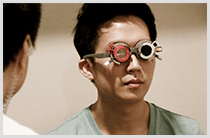
Subordinate Cycloplegic Refraction Test
After 3~5 days of the cycloplegic refraction test, when the medicinal effects have disappeared, another vision test is done. This is to calculate the change to more accurately measure myopia and astigmatism.
-
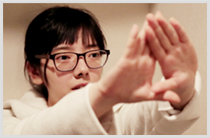
Dominant Eye Test
This is to find out which one of your eyes is the dominant one.
Cornea Test
-

Corneal Topography Test
With a slit CT scan, the topography, curvature, thickness, shape and symmetry of the cornea are measured. This test enables a true customized surgery for each individual. Also, this test can detect irregular astigmatism, cataract, and glaucoma as well as measure the anterior and posterior corneal shape, cornea thickness, and front depth.
-

Eyeglass Test
It’s an exam to check up both the radius of curvature and diopter of cornea, which it lets us know the cornea’s shape, flatness and conical cornea, pupil size.
-

Automatic Refractive Power Test
This an eye exam is to let us know its eyes state especially the radius of curvature and diopter. Through this exam, we could get to know flatness, pupil size, cornea shape and conical cornea state etc.
-

Manifest Refraction Test
Corneal endothelial cell is a polygonal cell, which is normally six-pointed and in the deepest spot of cornea. Adults usually have them over 2,000. The test for corneal endothelial cell is state-of-the-art test which looks carefully into endothelial cell inside the cornea.
-

Cycloplegic Refraction Test
Cycloplegic eye drops are used to temporarily paralyze the ciliary muscles that control focusing to determine your exact refractive error.
-

Subordinate Cycloplegic Refraction Test
Since it’s the most essential test for eyes condition, ‘doctor’ looks carefully at the cornea shape and whether or not these are going well.
Retina Test
-

Optic Nerve & Retina Test
An optic nerve and retina CT scan diagnoses any retina diseases such as retina disorders, glaucoma and optic nerve damage
-

Fundus Test
The overall condition of the optic nerves and retina is reviewed to diagnose any retina degeneration, diseases from previous injuries and also the degree of retina damage from diabetes and high blood pressure.
-

Retina Test
After enlarging the pupil, the optical nerves are examines with a special microscope. This test diagnoses/checks for any abnormality in the optical nerves or central retina area, glaucoma, injury related diseases, retina damage from diabetes or high blood pressure, and intraocular tumors.
Keratoconus Test
-

Automatic Refractive Power Test
Your exact refraction error is measured by used the most advanced optical equipment.
-
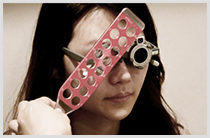
Manifest Refraction Test
Your maximum correct vision with glasses can be predicted with visual acuity test. The calculated maximum corrected vision is theoretically the maximum post-operative vision you will have.
-

Corneal Curvature Test
The corneal pattern and oblateness, keratoconus and pupil size can be measured by examing the corneal curvature range and refraction range
-

Corneal Topography Test
With a slit CT scan, the topography, curvature, thickness, shape and symmetry of the cornea are measured. This test enables a true customized surgery for each individual. Also, this test can detect irregular astigmatism, cataract, and glaucoma as well as measure the anterior and posterior corneal shape, cornea thickness, and front depth.
-

Corneal MRI Test
By displaying the exact condition of your cornea, iris, and lens in three dimensions, the corneal topography can be accurately measured. A simulation of the corneal flap thickness before and after surgery can be used to predict and prevent any side effects that could occur.
Glaucoma Test
-

Eye Pressure Test
The eye pressure is measure without actual contact. This allows for early diagnosis of glaucoma or to comprehend the exact condition of glaucoma and optic nerves.
-

Comprehensive Visual Field Test MATRIX
This essential exam diagnoses glaucoma and any retina abnormality by checking light reaction and glaucomatous nerve damage.
-

Fundus Test
The overall condition of the optic nerves and retina is reviewed to diagnose any retina degeneration, diseases from previous injuries and also the degree of retina damage from diabetes and high blood pressure.
-

Comprehensive Visual Field Test HUMPHREY
If the results from the MATRIX test were negative, this test allows for a more thorough/detailed examination to check for not only glaucoma but also for retina abnormality and macular degeneration.
-

Optic Nerve & Retina Test
An optic nerve and retina CT scan diagnoses any retina diseases such as retina disorders, glaucoma and optic nerve damage
-
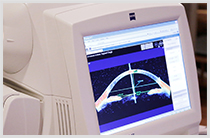
Cornea MRI Test
By displaying the exact condition of your cornea, iris, and lens in three dimensions, the corneal topography can be accurately measured. A simulation of the corneal flap thickness before and after surgery can be used to predict and prevent any side effects that could occur.
Night Blurred Vision Test
-

Pupil Size Test in the dark
People with excessive myopia experience night blurred vision mostly because the sizes of their pupils are much larger at night. So by measuring the exact size of your pupils in a dark surrounding, the possibility of post operative side effects can be predicted. and your surgeon can decide on the size of the corneal flap and the range and method of laser that will be used.
-

Automatic Pupil Size Test
This test measures the corneal pattern and oblateness, keratoconus and pupil size by examining the corneal curvature range and refraction range.
-

WaveFront Test
Using the Tscheming method that directly observes the WaveFront aberration, this test will analyze the anterior and posterior cornea as well as HOA, another cause that hinders vision beside myopia and astigmatism.
-

Automatic Refractive Power Test
Your exact refraction error is measured by used the most advanced optical equipment.
Tear Production Test
-

Tear Production Test
The Schirmer Test measures your tear production to predict the temporary dry eye condition you might experience after surgery.
-

Slip Lamp Test
The binocular slip-lamp examination provided a stereoscopic magnified view of the eye structures in detail, enabling your specialist to diagnose various eye conditions.
-

Tear Breakup Time
Fluorescein is instilled into your tear film and the time that elapses between the last blink and the appearance of the first dry spot in the tear film is recorded. This clinical test is used to assess for evaporative dry eye disease.
IOL Test
-

Corneal Topography Test
With a slit CT scan, the topography, curvature, thickness, shape and symmetry of the cornea are measured. This test enables a true customized surgery for each individual. Also, this test can detect irregular astigmatism, cataract, and glaucoma as well as measure the anterior and posterior corneal shape, cornea thickness, and front depth.
-

Manifest Refraction Test
Your maximum correct vision with glasses can be predicted with visual acuity test. The calculated maximum corrected vision is theoretically the maximum post-operative vision you will have.
-

Cycloplegic Refraction Test
Cycloplegic eye drops are used to temporarily paralyze the ciliary muscles that control focusing to determine your exact refractive error.
-

Subordinate Cycloplegic Refraction Test
After 3~5 days of the cycloplegic refraction test, when the medicinal effects have disappeared, another vision test is done. This is to calculate the change to more accurately measure myopia and astigmatism
-

Automatic Refractive Power Test
Your exact refraction error is measured by used the most advanced optical equipment.
-

Corneal MRI Test
By displaying the exact condition of your cornea, iris, and lens in three dimensions, the corneal topography can be accurately measured. A simulation of the corneal flap thickness before and after surgery can be used to predict and prevent any side effects that could occur.
-

Eye Pressure Test
The eye pressure is measure without actual contact. This allows for early diagnosis of glaucoma or to comprehend the exact condition of glaucoma and optic nerves.
-

A-Scan Test
Ultrasound if used to determine the exact condition of your eyes. Information needed for cataract surgery or IOL surgery such as the length of your eyeball, frontier depth, any existence of foreign substances, and your retina are measure and evaluated
-

Corneal Endothelial Cell Test
Corneal endothelial cell is a polygonal cell, which is normally six-pointed and in the deepest spot of cornea. Adults usually have them over 2,000. The test for corneal endothelial cell is state-of-the-art test which looks carefully into endothelial cell inside the cornea.
-
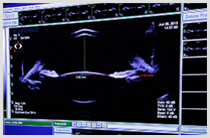
UBM Test
Check for any diseases behind the iris and measure the actual size of the lens
-

Ultrasonic Waves Corneal Thickness Test
This test is to examine the thickness of corneal. To put it concretely, it measures the thickness of the central part of corneal using ultrasonic waves after topical anesthesia. This examination is essential for highly myopic patients
-

Comprehensive Visual Field Test MATRIX
This essential exam diagnoses glaucoma and any retina abnormality by checking light reaction and glaucomatous nerve damage.
-

Slip Lamp Test
The binocular slip-lamp examination provided a stereoscopic magnified view of the eye structures in detail, enabling your specialist to diagnose various eye conditions.
-

Retina Test
After enlarging the pupil, the optical nerves are examines with a special microscope. This test diagnoses/checks for any abnormality in the optical nerves or central retina area, glaucoma, injury related diseases, retina damage from diabetes or high blood pressure, and intraocular tumors.
Cataract Test
-

A Scan Test
Ultrasound if used to determine the exact condition of your eyes. Information needed for cataract surgery or IOL surgery such as the length of your eyeball, frontier depth, any existence of foreign substances, and your retina are measure and evaluated.
-

Manifest Refraction Test
Your maximum correct vision with glasses can be predicted with visual acuity test. The calculated maximum corrected vision is theoretically the maximum post-operative vision you will have.
-

Slip Lamp Test
The binocular slip-lamp examination provided a stereoscopic magnified view of the eye structures in detail, enabling your specialist to diagnose various eye conditions.
-

Automatic Refractive Power Test
Through advanced optics, we diagnose refractive errors such as myopia, astigmatism, and hyperopia.
-

Eye Pressure Test
The eye pressure is measure without actual contact. This allows for early diagnosis of glaucoma or to comprehend the exact condition of glaucoma and optic nerves.
-

Corneal Topography Test
With a slit CT scan, the topography, curvature, thickness, shape and symmetry of the cornea are measured. This test enables a true customized surgery for each individual. Also, this test can detect irregular astigmatism, cataract, and glaucoma as well as measure the anterior and posterior corneal shape, cornea thickness, and front depth.
-

Fundus Test
The overall condition of the optic nerves and retina is reviewed to diagnose any retina degeneration, diseases from previous injuries and also the degree of retina damage from diabetes and high blood pressure.
Consultation
-

Analyze Test Results
The exact condition of your eyes can be assessed with the results from the various comprehensive tests, so the most suitable surgery can be chosen for your eyes. Surgery method, recovery time, and any precautions before and after surgery will be informed, and any question and inquiries you might have will be answered.
-

Customized Surgery Consultation
A one-on-one consultation with your own private specialist will take place. You and your specialist will examine the results together to choose the right surgery method for you. The specialist that you consulted with will be your surgeon who will perform your surgery.


